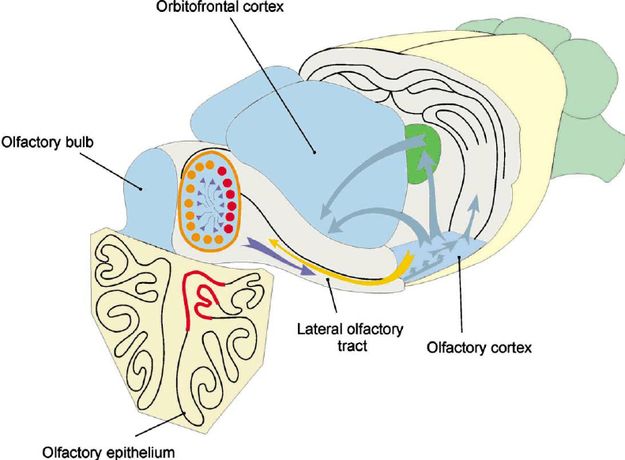Stepping outside the apartment on a crisp winter day, I am taken aback by a wave of memory washing over me. Despite the desolate, empty streets in Amsterdam under the current lockdown, the cold air has a particularly refreshing scent that takes me back to the time my cousins and I used to leave angel marks on the snow in Korea. Without seeing a snowflake on the ground, I can still recall the squeaky, deeply satisfying sound that my boots made on the fresh mattress. I am having a so-called ‘madeleine episode’, where fragile and ancient memories are enlivened through smell.
The word redolent originates from Latin word redolere, which means “to give out a strong smell” (re(d)- ‘back, again’ + olere ‘to smell’). As Proust’s narrative, other anecdotes and scientific researches alike have noted, smell and memory are intimately related. Among all the brain regions that receive information from different sensory organs, the olfactory bulb is the closest to the limbic system. The limbic system is essential to various fundamental cognitive functions, two of its constituents being the hippocampus —responsible for episodic memory— and amygdala —responsible for emotional responses—.
In fact, while information from other sensory organs are mostly sent to the higher cortical areas first, information that enters the nostrils travels to the limbic system first (Nieuwhof). This results in smell eliciting an immediate and visceral response like no other senses. Moreover, olfactory stimuli tend to be more complex and less redundant than other sensory stimuli (one breathes more odorants than they see or hear at any given moment), which can also explain the less likely decay of olfactory memories.
Research shows that when rats are conditioned to fear various stimuli, they extinguish fear response for olfactory cues at a later rate than for auditory or visual cues (Richardson et al.). Similarly, researchers have investigated how the survivors of the Vietnamese invasion in Khmer 1979 suffer from olfactory-triggered panic attacks— smells of gasoline and smoke remind them of the burning human bodies during the massacre (Hinton et al.).
Ironically, despite this salience of smell in the formation of everyday memory, because smell, unlike other senses, does not travel directly to the higher cortical regions responsible for abstract and linguistic abilities, it is less readily translated into and recorded as verbal information. Unlike other sensory memories that can be recounted to one’s convenience through mnemonic tools and symbols, smell, as strong, vivid and evocative as it is, only visits us rather ‘suddenly’ regardless of our volition, reminding us of memories that were deep asleep in the depths of our mind.
In Midnight’s Children, Rushdie akins the protagonist’s large nose and his extraordinary experience of smell in the maximally stimulating setting of India to the country’s history, its “annihilating whirlpool of the multitudes". Part of the psychiatric intervention used in treating Khmer refugees has been to ask them to verbalize their trauma into a coherent and flat narrative, and by doing so decrease the flashback intensity which bombards the senses (Hinton et al.). Just like history itself, smell is omnipresent and rich in information, to the extent that it can overwhelm us, yet much of it constantly escapes the grasp of our attempt to record it.
Earlier it has been mentioned that smell is closely related to emotions as well— it takes only two synapses for the information from the air to reach the amygdala (Herz). The direct linkage formed between smell, episodic memory and basic emotions has an evolutionary advantage. Smell, being a chemical sense, often serves as an immediate cue that tells us whether it is safe to eat a certain plant, a carcass that has been rotting for days, or to enter a place that starts smoking. It does not take effort to make the decisions; the mouth starts watering, or the face crumples with horror and disgust before one even has to consciously reason about the odorant.
Yet, none of these odorant-specific responses are biologically innate. Anyone who babysat before can account for the fact that infants do not distinguish between smells that adults often find pleasant or unpleasant, reaching out to anything that they find on the ground — from grass to dog droppings — and bringing them to their mouths. Herz argues that unlike animal species that stay within particular ecological niches, humans have moved into different climates and environments throughout generations, and have had to learn associations between safety and the flora and fauna specific to the region. Thus humans are not born with an innate sense of ‘good’ or ‘bad’ smell, but with the ability to make those associations between smell and the safety and/or familiarity of their odorants quickly.
Unfortunately such flexibility can also backfire, as infants whose mothers smoked or drank alcohol during pregnancy, showed later preference towards the substances after birth (fun fact: fetuses inhale twice as much amniotic fluid as they swallow) (Mennella & Beauchamp). This is to say that the human preference of odors are inherently context-dependent. The same odorant that is merely labelled differently, “vomit” for one group and “Parmesan cheese” for the other group, elicits very different ratings from the participants in terms of their likeability (Herz). But except for such ambiguous cases, most odors are highly specific to their odorants, and by the age of eight, children have strong preferences of odor that mimic the adults in their culture, preferences that are now deeply ingrained and difficult to change (Herz).
Once a child establishes their preferences within their specific cultural context, they also form neophobia, a cautious attitude towards all unfamiliar scents. Bodily smells (a plethora of scents resulting from the interactions between one’s diet, climate, clothing, lifestyle and the body) that pertain to the other have commonly been noted with rich detail in literature and historical records, often in a negative manner.
Allegedly the “Viet Cong were reputedly able to scent American troops by their cheesy odor, product of a high consumption of milk derivatives”, and “the Japanese once knew Europeans as bata-kusai (“stinks of butter”)”, while British diplomat Donald Maclean recorded Russian peasants as “gnarled beings whose ragged, sweat-soaked clothes exhaled a sour odor of corruption” (Porteous). The smell of the other becomes particularly pertinent as one becomes desensitized towards the familiar scents of their own culture (recall how you can only smell your room when you reenter it after being outside for a while).
The fact that smell is so readily associated with safety or danger, and the accompanying emotions of pleasure or suffering, carries much significance in social psychology. Unlike other senses that can be avoided (think of the Three Wise Monkeys image, one which blocks its eyes, another its ears and the last its mouth), one cannot prevent smelling things so long as they must breathe normally. If something smells foul, the message of danger that such odor signals (for the very ‘foulness’ is acquired through the past experiences that led one to associate the smell with danger), coupled with the inevitability of smelling it, leads one to feel as though they are morally violated.
Perhaps then it is not a surprise that for the Ilahita Arapesh community of Papua New Guinea, bodily odor is considered as the essence of a person, a significator for the person’s moral status (Tuzin), or that renowned Christian saints were reportedly able to smell the stench of human sin (Classen). Researches have shown that when participants are shown pictures of racial and socioeconomic outgroups, the same area in amygdala responsible for disgust is activated (Hart et al.; Harris & Fiske). The learned aversion against the unfamiliar not only makes one perceive the other to smell offensive, but also form an (unconscious, therefore more pernicious) intuitive, emotional response that they therefore are offensive.
Smell is often involuntarily perceived, and yet its effects in triggering a multitude of memories and emotions, consequently one’s behavior, can be tremendous and is often beyond our conscious recognition. The issues regarding the ethics of environmental fragrancing, such as one concerning the series of research aiming to develop scents to be released into the New York subway in order to induce pleasant mood and reduce aggression, are ever hotly debated (Damian & Damian).
Recently researchers have found that “olfactory receptors happened to be the most structurally diverse and sizable member of the largest multigene family of protein receptors in the mammalian genome (so-called G-protein coupled receptors—or GPCRs in short)”, with a genetic storage greater than that of the immune system (Barwich). It is indubitable that smell comprises a prominent part of our lives and experiences. Yet, this realization conceives many more questions regarding what the right means to use this knowledge are, how we shall embrace and enliven our memories and emotions, even while being cautious of their implications.

